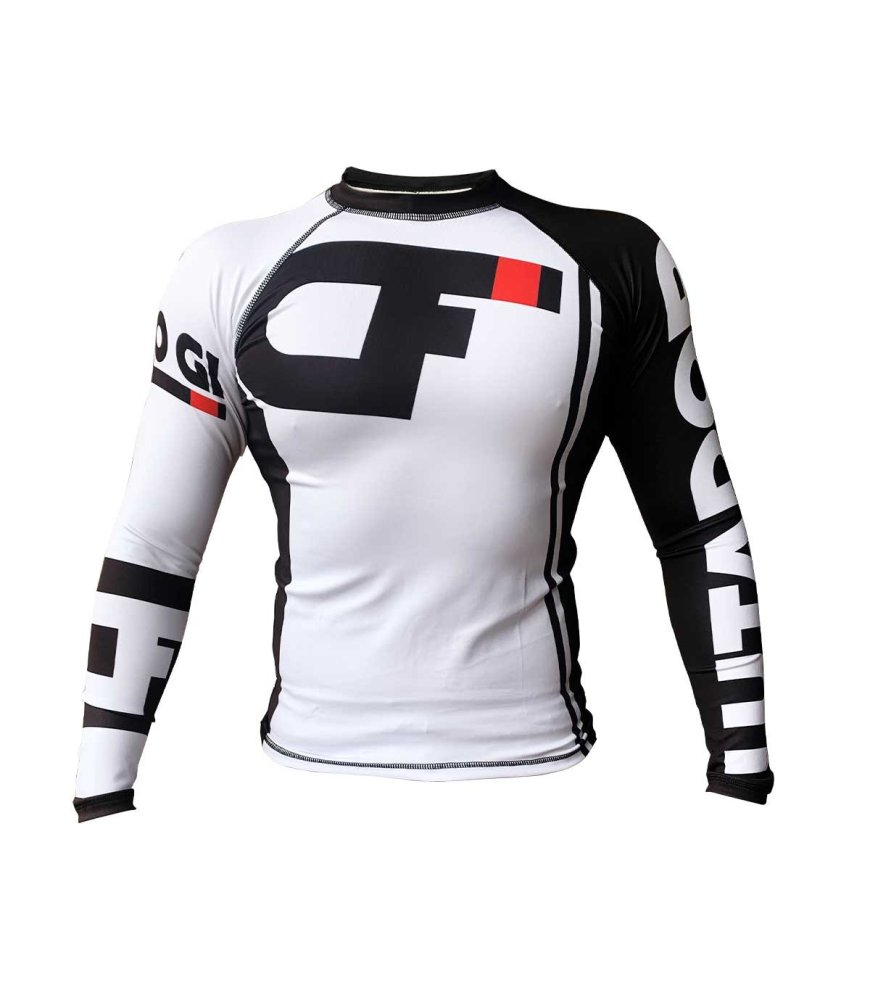8 Advanced Jiu Jitsu Workouts for Maximum Endurance
MMA Jitsu Gear offers a premium selection of BJJ Gis, No Gi rash guards, and top-quality Jiu Jitsu fightwear. Our products are designed for durability, comfort, and performance, catering to athletes of all levels. Whether you're training or competing, MMA Jitsu Gear ensures you have the best apparel to support your martial arts journey.

Jiu Jitsu is an intense and highly technical martial art that demands peak physical conditioning. To excel in this sport, one must not only master the techniques but also possess remarkable endurance. This article outlines eight advanced jiu jitsu workouts designed to maximize endurance, ensuring you can sustain high performance throughout your training and competitions. Whether you prefer long sleeve rash guards or short sleeve rash guards, these workouts will help you push your limits and achieve superior stamina.
1. Interval Sparring
Focus: High-Intensity Interval Training (HIIT)
Interval sparring is a potent method to build endurance for Jiu Jitsu. This workout alternates between periods of intense sparring and short rest intervals, mimicking the high-intensity bursts followed by brief recovery times experienced during matches.
How to Perform:
- Warm-Up: Start with a 10-minute warm-up, including dynamic stretches and light drilling.
- Rounds: Engage in 5-minute sparring rounds with 1-minute rest in between.
- Intensity: During sparring, maintain high intensity, aiming to push yourself to your limits.
- Repetitions: Complete 6-8 rounds per session.
Benefits: Interval sparring enhances cardiovascular fitness, muscular endurance, and mental toughness. It trains your body to recover quickly between intense efforts, which is crucial during competitions.
Gear Tip: Opt for long sleeve rash guards during interval sparring to prevent mat burns and provide extra protection.
2. Circuit Training
Focus: Full-Body Strength and Endurance
Circuit training combines strength exercises with cardiovascular activities in a continuous sequence, improving both muscular endurance and cardiovascular capacity.
How to Perform:
- Warm-Up: Start with a 10-minute warm-up, including dynamic stretches and mobility exercises.
- Stations: Set up 8-10 stations with different exercises, such as:
- Push-ups
- Pull-ups
- Kettlebell swings
- Burpees
- Medicine ball slams
- Battle ropes
- Jump squats
- Plank variations
- Duration: Spend 45 seconds at each station, followed by 15 seconds of rest.
- Rounds: Complete 3-4 circuits, with a 2-minute rest between each circuit.
Benefits: Circuit training enhances overall fitness, builds muscular endurance, and improves cardiovascular health. The variety of exercises targets multiple muscle groups, ensuring balanced development.
Gear Tip: Short sleeve rash guards are ideal for circuit training, offering breathability and freedom of movement.
3. Long-Distance Running
Focus: Cardiovascular Endurance
Long-distance running is a fundamental workout for building cardiovascular endurance, which is essential for sustaining prolonged physical activity during Jiu Jitsu matches.
How to Perform:
- Warm-Up: Start with a 10-minute warm-up, including dynamic stretches and light jogging.
- Distance: Aim to run 5-10 kilometers, depending on your fitness level.
- Pace: Maintain a steady, moderate pace throughout the run.
- Cooldown: Finish with a 10-minute cooldown, including static stretches.
Benefits: Long-distance running improves heart and lung capacity, enhances stamina, and helps maintain a healthy weight. It also strengthens the legs, which is crucial for maintaining a strong base in Jiu Jitsu.
Gear Tip: Choose lightweight and moisture-wicking long sleeve rash guards for long-distance running to stay comfortable and dry.
4. Plyometric Training
Focus: Explosive Power and Endurance
Plyometric training involves explosive movements that enhance power, speed, and muscular endurance. These exercises are particularly beneficial for Jiu Jitsu practitioners, as they improve the ability to generate force quickly.
How to Perform:
- Warm-Up: Start with a 10-minute warm-up, including dynamic stretches and light jogging.
- Exercises: Incorporate exercises such as:
- Box jumps
- Jump squats
- Plyometric push-ups
- Tuck jumps
- Broad jumps
- Repetitions: Perform 3-4 sets of each exercise, with 10-12 repetitions per set.
- Rest: Take a 1-2 minute rest between sets.
Benefits: Plyometric training boosts explosive power, enhances fast-twitch muscle fibers, and improves overall athletic performance. It also helps in developing quick and powerful movements, essential for executing Jiu Jitsu techniques.
Gear Tip: Short sleeve rash guards provide the necessary flexibility and breathability for plyometric exercises.
5. Resistance Band Workouts
Focus: Strength and Endurance
Resistance band workouts are excellent for building strength and endurance without the need for heavy weights. The constant tension provided by the bands targets stabilizing muscles and enhances muscular endurance.
How to Perform:
- Warm-Up: Start with a 10-minute warm-up, including dynamic stretches and mobility exercises.
- Exercises: Incorporate exercises such as:
- Band pull-aparts
- Squat to press
- Band-resisted push-ups
- Banded rows
- Monster walks
- Repetitions: Perform 3-4 sets of each exercise, with 12-15 repetitions per set.
- Rest: Take a 1-2 minute rest between sets.
Benefits: Resistance band workouts improve muscular endurance, enhance joint stability, and increase overall strength. They are also convenient and can be performed anywhere, making them ideal for supplementary training.
Gear Tip: Long sleeve rash guards are beneficial for resistance band workouts, providing extra protection and support.
6. Hill Sprints
Focus: Cardiovascular and Muscular Endurance
Hill sprints are a challenging workout that combines cardiovascular and muscular endurance training. Sprinting uphill engages the lower body muscles intensely, improving strength and

.
How to Perform:
- Warm-Up: Start with a 10-minute warm-up, including dynamic stretches and light jogging.
- Sprints: Find a hill with a moderate incline. Sprint uphill at maximum effort for 20-30 seconds.
- Recovery: Walk back down to the starting point for recovery.
- Repetitions: Repeat for 8-10 sprints per session.
Benefits: Hill sprints enhance cardiovascular endurance, build leg strength, and improve running mechanics. The high-intensity nature of this workout also boosts metabolic rate.
Gear Tip: Opt for short sleeve rash guards for hill sprints to stay cool and comfortable.
7. Grappling Dummy Drills
Focus: Technique and Endurance
Grappling dummy drills allow you to practice techniques and build endurance simultaneously. These drills simulate the resistance and movement of a live opponent, helping to improve technique and stamina.
How to Perform:
- Warm-Up: Start with a 10-minute warm-up, including dynamic stretches and mobility exercises.
- Drills: Perform drills such as:
- Guard passes
- Sweeps
- Submissions
- Transitions
- Duration: Spend 2-3 minutes on each drill, maintaining a high pace.
- Rounds: Complete 6-8 rounds, with 1-minute rest between rounds.
Benefits: Grappling dummy drills enhance technical proficiency, improve muscle memory, and build endurance. They allow you to focus on specific movements without the variability of a live opponent.
Gear Tip: Long sleeve rash guards are ideal for grappling dummy drills, offering protection and durability.
8. Swimming
Focus: Full-Body Endurance
Swimming is an excellent low-impact workout that builds cardiovascular endurance, muscular strength, and flexibility. It engages multiple muscle groups, providing a comprehensive workout for Jiu Jitsu practitioners.
How to Perform:
- Warm-Up: Start with a 10-minute warm-up, including dynamic stretches and light swimming.
- Laps: Swim continuous laps for 30-45 minutes, alternating between different strokes (freestyle, breaststroke, backstroke).
- Intervals: Incorporate interval training by sprinting for one lap, then swimming at a moderate pace for two laps.
- Cooldown: Finish with a 10-minute cooldown, including gentle swimming and static stretches.
Benefits: Swimming improves cardiovascular fitness, enhances lung capacity, and builds muscular endurance. The resistance of water provides a full-body workout while reducing the risk of injury.
Gear Tip: Wear short sleeve rash guards while swimming for added comfort and reduced drag in the water.
Conclusion
Building maximum endurance for Jiu Jitsu requires a combination of high-intensity training, cardiovascular workouts, and strength-building exercises. Incorporating these eight advanced Jiu Jitsu workouts into your training regimen will help you develop the endurance needed to perform at your best during matches. Whether you prefer long sleeve rash guards for added protection or short sleeve rash guards for better breathability, ensure you choose gear that supports your training and enhances your performance.
Remember to stay consistent, push your limits, and focus on recovery to achieve optimal results. With dedication and the right training approach, you'll be well on your way to maximizing your endurance and excelling in Jiu Jitsu.
What's Your Reaction?
 Like
0
Like
0
 Dislike
0
Dislike
0
 Love
0
Love
0
 Funny
0
Funny
0
 Angry
0
Angry
0
 Sad
0
Sad
0
 Wow
0
Wow
0
Related Posts
Medical Fixation Devices Market Set to Witness Explosiv...
nitinrrr Nov 30, -0001 0






















































